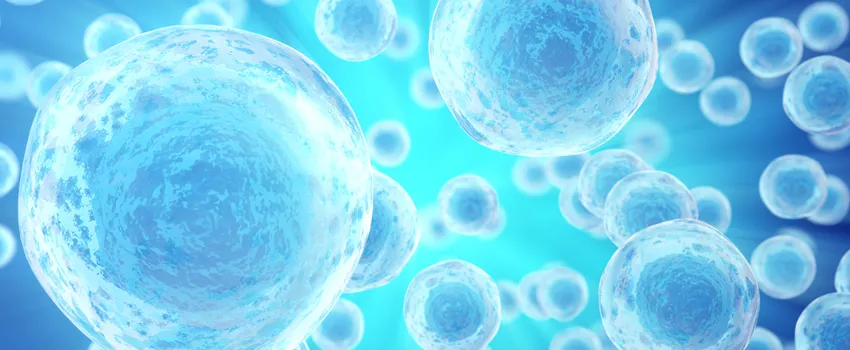
Photo by Rost9, Shutterstock.
Stanford Medicine Scope - July 26th, 2017 - by Krista Conger
The saying “it takes a village” usually refers to the many different kinds of people — parents, grandparents, neighbors, teachers and care providers — who play a role in bringing up a successful, happy child. But it could also be used to describe the many types of proteins that guide the fate of stem cells in the body.
How does a muscle stem cell, for example, know when and how to become a muscle cell? Experts believe that it’s nudged along the appropriate developmental pathway by the cells and proteins it meets along the way, as well as by a network of materials outside the cell known as the extracellular matrix.
Researchers know that it is possible in the laboratory to create many different kinds of cells from induced pluripotent stem cells by exposing them to specific cocktails of proteins, which have usually been identified by trial and error. But it’s hard to know exactly whether this hit-or-miss approach accurately reflects what happens inside the body, and whether the creation process (known as differentiation) could be improved.
Now cardiology researcher and bioengineer Ngan Huang, PhD, and postdoctoral scholar Luqia Hou, PhD, have devised a way to quickly assess the effect of many combinations of proteins on the differentiation of stem cells into endothelial cells, a type of cell important in the formation of blood vessels. They use a kind of cellular speed dating to pinpoint the combinations most likely to be clinically useful. They report their results in Scientific Reports.
As Huang explained to me in an email:
Stem cell therapy using induced pluripotent stem cell-derived endothelial cells holds great promise to treat cardiovascular diseases by inducing angiogenesis, or the formation of new vessels. In order to bring cell therapy to the clinical setting, we need to generate billions of high-quality cells. We used what is called a high-throughput extracellular microarray to assess hundreds of different protein combinations at the same time. It requires minimal amounts of stem cells, medium and reagents, all of which are very expensive in stem cell research. In addition, it provides an efficient way to evaluate the full profile of all possible combinations of extracellular matrix proteins.
To do this, the researchers dot various combinations of proteins found in the extracellular matrix on a glass slide to create individual microenvironments less than half a millimeter in diameter. The array was then seeded with induced pluripotent stem cells, which were allowed to grow for five days. The researchers then assessed the cell spots to determine which were expressing the highest levels of a protein associated with endothelial cells. Their approach generated some interesting findings.
As Huang explained:
In terms of regulating cell behavior, one might expect the effects of combining different extracellular matrix proteins would be additive. That is, if two proteins had a positive impact in promoting cell differentiation when applied separately, adding both together would be even better. On the contrary we found that was not always true. Sometimes combining two ‘good’ proteins would actually inhibit differentiation. Therefore, it’s critically important to learn how cells respond to cues from more than one ECM protein simultaneously.
For example, the researchers found that, although a protein called collagen IV alone only poorly supported the differentiation of stem cells into endothelial cells, it was an essential component of all of the top protein combinations.
The high-throughput array could also be used to study differentiation into other cell types, or to test the response of stem cells to different drugs, the researchers point out. They’d also like to develop a three-dimensional array to study how the newly formed endothelial cells organize themselves in response to external signals to create working blood vessels.
“Ultimately, we’d like to use this technology to bridge the gap between pre-clinical studies in animals and clinical trials in humans to benefit people with myocardium infarction or periphery artery diseases,” Huang said.


